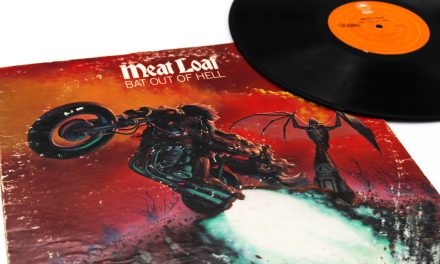If Black Sabbath are the grandfathers of heavy metal, then Judas Priest is the father that outdid them in almost every way. If you ask me to show someone what heavy metal is, I won’t hand them a copy of Paranoid or Master of Reality. I’ll instead hand them a copy of Screaming For Vengeance, British Steel, or Painkiller. That’s what Judas Priest means to the heavy metal community. Without them we wouldn’t have a classic look for heavy metal with studs and leather.
Thin Lizzy and Wishbone Ash might have been the first to use the twin-guitar attack, but Judas Priest was the one that solidified it in the heavy metal sphere. K.K. Downing and Glenn Tipton were and still are probably the best twin guitarists for any band. It was set to be the 50th anniversary celebration for Judas Priest this year. To make up for those shows being postponed, it’s high time for Judas Priest-A-Thon. The brother to the album by album reviews, Iron Maiden-A-Thon and the cousin to our series of Rush album reviews. You’re going to be getting a Judas Priest album review, every business day, until we’re all through.
Judas Priest made an instant classic album with Stained Class. It didn’t take them long to get back into the studio to record a follow-up though. Coming a merely eight months after that album, depending on where you live, Killing Machine/Hell Bent For Leather was a radical departure to that sound. Stained Class was the last vestiges of that 70’s era bluesy power sound from the band. They would be in search of a more commercial friendly sound.
Background on Killing Machine/Hell Bent For Leather
I bet if you don’t know, you’re wondering why I keep typing Killing Machine/Hell Bent For Leather. The story behind the US getting Hell Bent For Leather in 1979 and the rest of the world getting Killing Machine is controversial.
Before the release of Killing Machine in the US, there was a school shooting in San Diego. At Grover Cleveland Elementary, Brenda Spencer shot and killed two people and injured another nine before she was apprehended. CBS Records decided to change the name of the record in the US to Hell Bent For Leather. That cut of the album had a different tracklisting than the earlier British release. For the sake of this review, I’ll be calling the album Killing Machine going forward, but we’ll use that US tracklisting.
It was produced by “Better By You, Better Than Me” producer James Guthrie. Killing Machine was recorded at Utopia Studios in London. The overall production for the album was the best that the band had done to that point. It stripped away the dark, fantasy lyrics from previous releases in favor of a more commercial sound. None of the songs on the album are longer than around four minutes, which was also a first for the band.
Killing Machine is definitely a turning point for the band where they made a distinct change. Let’s get on with the review.
1. Delivering The Goods
Right off the bat, you can tell this is a different form for Judas Priest. It signaled their evolution to the studs and leather that they famously wear now. “Delivering The Goods” can be seen as a straightforward rocker that doesn’t really have much substance to it. There’s a hint of S&M/bondage culture here also. I prefer not to look that deeply into the song and just enjoy it for what it is. It’s a fantastic opener that I’m glad made it’s way back to setlists during the Firepower World Tour.
2. Rock Forever
This one seems like a very straightforward, and I’m going to say this in the most puntastic way possible, rocker. It’s just espousing the greatness of rock and roll and that we should all aim to rock forever. There’s a very off chance that it could be about drugs, but that’s not a great message from Judas Priest. I’m fairly certain it’s just a harmless song.
That doesn’t make it a Judas Priest classic though. I find it a little repetitive and these sort of generic rocker songs clash with what people previously thought about Judas Priest. This isn’t one that I play regularly on my Priest playlists.
3. Evening Star
If the last song didn’t really have any sort of lyrical oddities, this one for sure does. “Evening Star” could be seen as a man finding God or Jesus. As referenced by Revelations, Jesus calls himself the morning star, other-known as the evening star. There’s another equally as plausible explanation for this one, that’s Lucifer. Which translates to Lord of Light, or Lightbringer, which is also what Venus is called. Or, the evening star.
The third and final possibility is that it’s just a person who’s found their own way in life and becomes more powerful as a result. It’s one of the longer tracks on the album. And it tells a great story of resolve and how to find your way in life. I also can’t say that this is one of my favorite Judas Priest songs, but it’s not bad because of that.
4. Hell Bent For Leather
A Priest classic through and through. If you’ve seen Judas Priest, you’ve seen them perform this song. You’ve seen Rob Halford ride out on the Harley Davidson. It’s a classic song that definitely sounds better live but still rocks out on the studio track. A simple track about a badass biker who can’t be beaten in races. This is the track that a lot of people point to when they think of the tonal and aesthetic shift of Judas Priest to the 80’s.
There’s not much to say other than this song is a classic through and through. Every time I think I get tired of them playing it live or I get tired of hearing it. I remember the roar of the crowd when those Harley noises are piped into the arena. Any sort of weariness is gone, and you’re just headbanging around with the rest of the metal maniacs.
5. Take On The World
If you thought Judas Priest was done trying to imitate Queen, then you should listen to “Take On The World”. It was written to be a similar style to “We Will Rock You”. An arena pleasing, rip-roaring, sing-a-long this is, but it’s not a classic Judas Priest song. It’s about standing up for what’s right and banding together to defeat evil and all that. It really sounds goofy when you listen to it with the rest of the record. Definitely a silly one that I’m sure all the die-hard 70’s Priest fans have a problem with. I recommend listening only because it’s silly fun to sing along with. At least they got that right.
6. Burnin’ Up
Finally we have another headbanging tune. The album started off strong in that department, but dipped a bit. “Burnin’ Up” comes complete with a strong riff and a pretty catchy chorus. It starts off slow but then breaks down the door with a heavy bluesy riff.
This one has the most straightforward lyrics on the album. It’s about sex and lust. There’s no hiding it. This is about the feelings you get when you want someone so bad that you start sweating and burning up about it. This is another in the vast departure from the previous lyrics of the band. It’s a pretty good track but it falls a bit short for me.
7. The Green Manalishi (With the Two-Pronged Crown)
Originally a Fleetwood Mac song, this one is another like “Diamonds and Rust” that Judas Priest made their own. According to the original writer, Peter Green, he had a dream where he saw a green dog that represented money, and the two pronged crown represented the devil. So that became the “Green Manalishi”. Like “Hell Bent For Leather” this track is great on the studio recording, but when you hear them play it live, it’s a whole different experience. The crowd interaction as the solos begin from both guitarists are second to none.
A Priest classic through and through, it showed that they could take any piece of music for a cover and make it awesome.
8. Killing Machine
The true title track of the album. This is one that they didn’t bring out live for many years up until their Firepower World Tour. About a badass contract killer that loves their line of work, it combines the lyrics of previous eras of Priest with their new more commercial sound. It’s a very “Dirty Deeds” style song that doesn’t have as exaggerated lyrics. Not one that you should forget about when you’re listening to this album.
9. Running Wild
“Running Wild” is the most underrated track on the album for me. How this one didn’t become a Priest classic that went on the charts is beyond me. It has all the parts of the formula. It comes with a sick riff to draw in the hardcore and heavy crowd, it’s got a great chorus, and the lyrics are easy to interpret and sing along with. The song tells about late-night partying and excess. A rebel against society that doesn’t stop for anyone and doesn’t listen to what authority has to say. This is a great song that should be recognized more as the classic that it is.
10. Before The Dawn
The only ballad on the album. “Before The Dawn” sort of breaks the habit that the band had been forming with this album. It’s completely filled to the gills with fast and hard rockers, but then this song is stuck here at the end of the tracklist. The lyrics are about a lover or a couple that are going through hard times. Our narrator knows that the person is going to leave and after the dawn, they realize it’s too late to patch anything up.
For a ballad, it’s not one that overstays it’s welcome but it’s really held up by the vocal abilities of Rob Halford. Without him, this wouldn’t be anything remotely special. Not one that I’m super into, but a good song for this type of mood.
11. Evil Fantasies
Our last track on the album brings back the rocking overall sound. This last one might be a little more thinly veiled about it’s subject matter, but it’s about sex, lust, S&M, the whole shebang. Some might say this has a different tone to it after Rob Halford came out as gay, I say that’s some bullshit. The song can be attributed to whatever sexual orientation you want to. Other than the subject matter, the song is a bit of a generic one. I don’t really dig it like some of the other songs on the album.
Score, Conclusion, and Analysis of Killing Machine

Like the vocal and tonal departure that it represents, Killing Machine is not a great album in the vein of the previous three for the band. It has a sort of halfway sound that the band wouldn’t perfect until their next album British Steel. This album feels very much like British Steel .05 when I listen to it. The ideas are there for some great tracks, but others aren’t executed very well. The top holds this album up from a middling score.
Killing Machine is an album that I feel has this mystique and aura to it. It feels like it should be a Priest classic alongside those other albums. But when you go through the whole album, what tracks stick out? “Hell Bent For Leather, “Running Wild”, “Green Manalishi”, “Delivering the Goods”, and maybe “Killing Machine”. The others I believe are skippable. So for that fact, I’m not going to shit on the album too much, but it gets a 7.5/10 from me. It might be the reason why we get the superb British Steel later, but that’s not a good enough reason to give it a higher score.
Judas Priest would fire Les Binks as their drummer after recording the “live” album Unleashed In The East. I won’t be reviewing that one for the main series of Judas Priest-A-Thon, but it’ll for sure be one that I’ll look at later. Their next album would change the course of heavy metal history. You’ll have to check back tomorrow for that one though.
For more on Judas Priest, heavy metal, or anything pop culture related, make sure to check back to That Hashtag Show.





